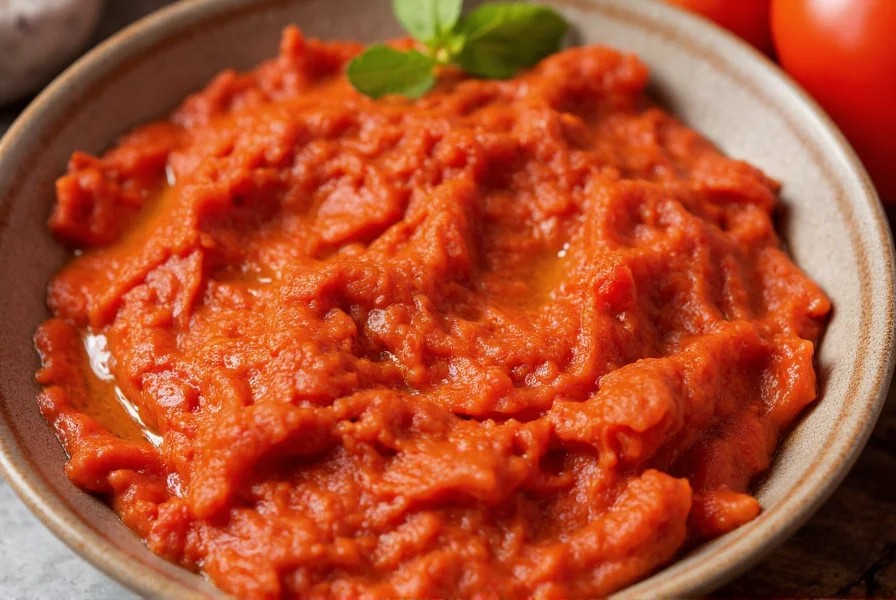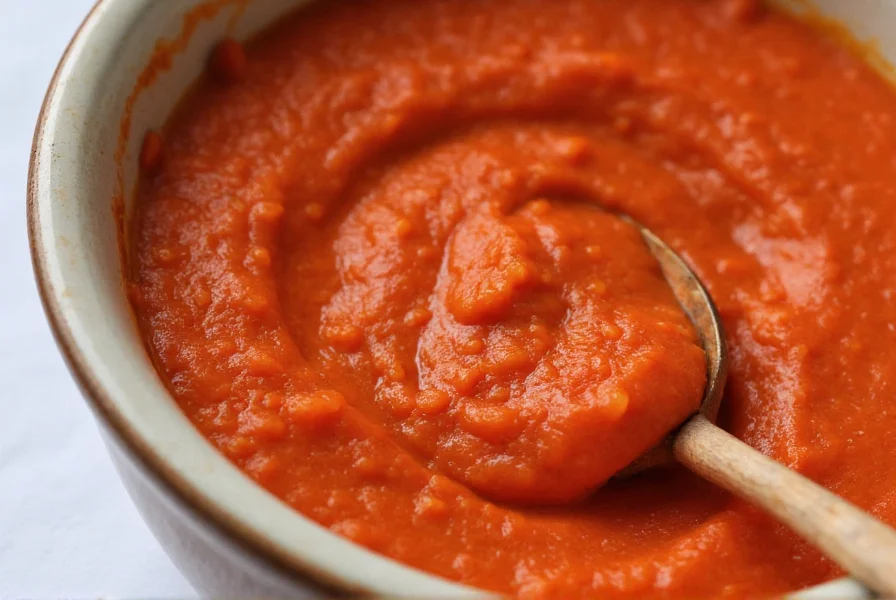Red pepper spread has become a staple in modern kitchens for its versatility and rich flavor profile. This vibrant condiment transforms ordinary meals with its sweet, smoky notes while providing essential vitamins from bell peppers. Unlike processed alternatives, quality red pepper spread maintains the natural sweetness of roasted peppers without excessive sugar or artificial additives.
What Makes Red Pepper Spread Unique
While many confuse red pepper spread with pimento spread or roasted red pepper dip, key differences exist. Traditional red pepper spread uses roasted bell peppers as the primary ingredient (typically 60-70% of the mixture), creating a smoother texture than chunky dips. The roasting process caramelizes natural sugars, producing complex flavor notes that raw peppers can't match.
Authentic recipes avoid artificial coloring—relying solely on the natural pigments from ripe red bell peppers. This distinguishes it from pimento spread, which often uses jarred pimentos and includes cheese or nuts. The best red pepper spreads maintain a balance between sweet pepper flavor and savory supporting ingredients like garlic, vinegar, and herbs.

Varieties of Red Pepper Spread
Understanding the different types helps you select the perfect spread for your culinary needs:
| Type | Key Characteristics | Best Uses |
|---|---|---|
| Traditional Roasted | Simple ingredients: peppers, olive oil, garlic, vinegar | Sandwiches, wraps, as base for sauces |
| Spicy Variation | Includes red pepper flakes or cayenne | Meat glazes, spicy mayo replacement |
| Mediterranean Style | Added herbs like oregano, lemon zest | Vegetable dips, mezze platters |
| Creamy Version | Contains yogurt or cream cheese | Appetizer spreads, vegetable dip |
Culinary Applications Beyond the Sandwich
While many use red pepper spread as a sandwich condiment, its culinary applications extend far beyond. Chefs appreciate its ability to enhance dishes without overpowering other flavors. When incorporated into sauces, it adds natural sweetness that balances acidic ingredients like tomatoes or vinegar.
For home cooks exploring red pepper spread recipes, consider these innovative uses:
- Mix with Greek yogurt for a quick vegetable dip
- Use as pizza sauce base for Mediterranean-style pizzas
- Blend with cream cheese for stuffed chicken breasts
- Stir into pasta sauces for added depth and color
- Spread on fish before baking for a flavor crust
Perfect Pairings for Red Pepper Spread
Understanding what foods pair well with red pepper spread elevates your culinary creations. The sweet-savory profile complements both rich and delicate flavors:
Protein Pairings: Grilled chicken, roasted turkey, baked fish, and hard-boiled eggs create satisfying combinations. The spread's acidity cuts through fatty proteins like pork or lamb exceptionally well.
Cheese Combinations: Fresh mozzarella, feta, and goat cheese provide contrasting textures that work beautifully with the smooth spread. Avoid strongly flavored cheeses that might compete with the pepper's natural sweetness.
Bread Selections: Choose crusty artisan breads, pita, or crackers with neutral flavors to let the spread shine. Sourdough provides a pleasant tang that complements the sweetness.

Creating Homemade Red Pepper Spread
While store-bought options exist, making homemade red pepper spread ensures freshness and allows customization. The process requires minimal equipment but delivers superior flavor:
- Roast 4 large red bell peppers over open flame or under broiler until charred
- Place in covered bowl for 10 minutes, then remove skins and seeds
- Combine peppers with 2 cloves garlic, 2 tbsp olive oil, 1 tbsp vinegar, and pinch of salt
- Blend until smooth but slightly textured
- Adjust seasoning with black pepper and optional red pepper flakes
This basic homemade red pepper spread recipe yields approximately 1.5 cups. For creamier texture, add 2 tablespoons of Greek yogurt. The spread maintains quality for one week refrigerated in an airtight container.
Nutritional Profile and Health Benefits
Red pepper spread offers notable nutritional advantages compared to traditional condiments. Bell peppers provide significant vitamin C (one medium pepper contains more than an orange) and vitamin A. The healthy fats from olive oil enhance absorption of these fat-soluble vitamins.
When evaluating red pepper spread nutritional benefits, consider these facts:
- Low in calories (approximately 25-40 calories per tablespoon)
- Naturally sugar-free (unlike many processed condiments)
- Contains capsaicinoids that may support metabolism
- Provides antioxidants like lycopene and beta-carotene
- Gluten-free and suitable for most dietary restrictions
Compared to mayonnaise-based spreads, red pepper spread typically contains one-third the calories and no cholesterol, making it a heart-healthier alternative for daily use.
Storage and Shelf Life Considerations
Proper storage maintains both safety and flavor quality. Commercially prepared red pepper spread typically remains fresh for 6-8 months unopened. Once opened, consume within 7-10 days for optimal flavor and safety.
For homemade red pepper spread storage, follow these guidelines:
- Store in airtight container with minimal air exposure
- Keep refrigerated at or below 40°F (4°C)
- Use clean utensils to prevent contamination
- Consume within 5-7 days for best quality
- Freeze in ice cube trays for longer storage (up to 3 months)
Signs of spoilage include mold growth, sour smell, or separation that doesn't reincorporate when stirred. When in doubt, discard the product.
Frequently Asked Questions
- What's the difference between red pepper spread and pimento spread?
Red pepper spread uses roasted bell peppers as the primary ingredient with a smoother texture, while pimento spread typically contains jarred pimentos, cheese, and nuts, resulting in a chunkier consistency. Authentic red pepper spread relies on fire-roasted peppers for depth of flavor without dairy ingredients. - Can I use red pepper spread as a pizza sauce?
Yes, red pepper spread makes an excellent pizza sauce alternative. Its natural sweetness complements Mediterranean toppings like goat cheese, olives, and artichokes. For best results, thin the spread slightly with olive oil or water to achieve proper sauce consistency before baking. - Is red pepper spread suitable for vegan diets?
Most traditional red pepper spreads are naturally vegan, containing only peppers, olive oil, garlic, and seasonings. Always check labels for dairy or egg ingredients, especially in creamy variations. Homemade versions can be easily customized to maintain vegan integrity. - How can I make my red pepper spread less spicy?
To reduce spiciness in red pepper spread, increase the ratio of roasted peppers to other ingredients, add a teaspoon of honey or maple syrup to balance heat, or incorporate a tablespoon of plain yogurt or tahini. Removing seeds and white membranes from peppers before roasting also prevents unwanted heat. - What are the best ways to use red pepper spread in meal prep?
Red pepper spread excels in meal prep applications: spread on sandwiches that won't get soggy, mix into grain bowls for added moisture, use as a base for salad dressings, or stuff into chicken breasts before cooking. Its vibrant color and stable texture make it ideal for prepping meals up to three days in advance.











 浙公网安备
33010002000092号
浙公网安备
33010002000092号 浙B2-20120091-4
浙B2-20120091-4